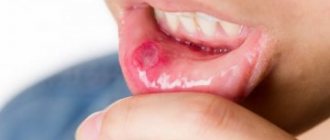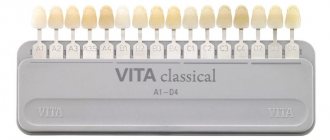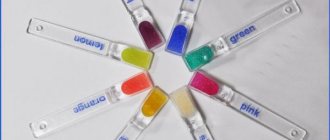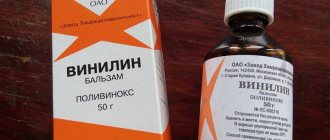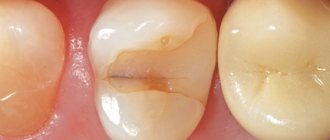3881
In dentistry, there are several types of filling materials, differing in composition, characteristics and release form.
Due to its unique properties, glass ionomer cement is most popular among specialists.
general information
GIC (abbreviated name for glass ionomer cement) is a type of dental material with a heterogeneous (inhomogeneous) structure.
The material was created by Kent and Wilson in 1969 by combining the properties and characteristics of polyacrylic and silicate substances.
Combining the properties of these groups, it has found its use as an insulating liner, raw material for aesthetic restoration, sealing fissures, creating gaskets, filling baby teeth and root canals.
Restoring the integrity of teeth with glass ionomers is gradually replacing cements based on zinc-polycarboxylate and zinc-phosphate.
Composite or glass ionomer cement
With the advent of composite materials and modern adhesive systems, glass ionomer cements and compomers began to lose their positions. But in some situations they can be irreplaceable. For example, as a temporary restoration for a long time (when absolute tightness is required for 6-12 months), in pediatric dentistry, in the absence or contraindications to the use of a rubber dam, and in orthopedic dentistry when fixing core inlays and metal-ceramic crowns.
In all other cases, it is still worth giving preference to more reliable, long-life composite materials with appropriate adhesive preparation of the cavity.
Sources:
- https://mnogozubov.ru/stekloionomernyjj-cement-sic/
- https://www.vash-dentist.ru/lechenie/zubyi/plombyi/stekloionomernogo-tsementa.html
- https://stomat.org/stekloionomernye-tsementy.html
- https://odonta.org/article/restavratsiya/75-stekloionomery-sostav-i-adgeziya
- https://zubovv.ru/lechenie/zubyi/plombyi/stekloionomernogo-tsementa.html
- https://dentazone.ru/preparaty-oborudovanie/materialy/stekloionomernye-cementy.html
Compound
The constituent components of cement are chemical compounds that determine its basic properties, namely:
- Crushed quartz 40% (silicon dioxide) – adds transparency, slightly lengthens the working time and the hardening period, slows down the hardening process, and slightly reduces the strength of the hardened mass.
- Aluminum phosphate - while worsening transparency, improves mechanical stability, strength, and structural stability.
- Aluminum oxide – increases strength and acid resistance, but reduces the hardening period and working time.
- Barium salts – added for radiopacity.
- Calcium fluoride - introduced to prevent the recurrence of caries.
This extensive combination of components allows glass ionomer cement to be used in many types of dental work.
Characteristics of Spectrum fillings and expert reviews about the material.
Come here to learn more about the types of cement fillings for teeth.
At this address https://www.vash-dentist.ru/lechenie/zubyi/kofferdam-v-stomatologii.html we will talk about the use and types of rubber dam in dentistry.
Classification
GIC is classified according to several criteria:
- According to the release form.
- According to the chemical composition.
- By area of application.
According to the form of release, the material is classified into the following types:
- Powder-liquid . The composition is traditional - the powder part is represented by finely dispersed aluminofluorosilicate cement with various additives, and the liquid is a water-based carbon copolymer containing tartaric acid.
- Pasty mass in tubes . During operation, mixing is avoided; it hardens when illuminated with a halogen lamp.
- Aquacement . The main component is present in the powder. The powder part is mixed only with distilled water.
- Capsules. In them, the liquid and powder part are packaged in the required ratio. Each capsule contains the required volume of material for one-time use, which eliminates errors and inaccuracy of dosage when preparing the mixture.
According to the chemical composition, GIC is divided into two groups:
- Classic .
This includes powder cement and aqua cement, the main components of which are phosphate and aluminum oxide, strontium, silicon dioxide, fluorides, zinc, and barium salts. In the case of aqua powder, crystals of one of the polycarboxylic acids are added to the composition. The liquid is distilled water or an aqueous solution of polycarboxylic acid. - Hybrid. This is a modified polymer variety. The composition of the powder part is similar to the classical group.
The liquid part is represented by a solution of acids of the polycarboxylic group, the molecules of which are modified by the addition of a methacrylate unsaturated group.Hydroxyethyl methacrylate, camphoroquinone, and tartaric acid were also added. Hardening takes place in 2-3 stages.
The last category includes two subtypes of cement:
- Aesthetic .
The composition has increased the content of silicon oxide, which improves aesthetic characteristics. Strength is reduced, the hardening period is increased and susceptibility to moisture is increased. It is used for the restoration of cervical defects located in the frontal part of incisors and canines, as well as for their caries, closing cavities of 1-2 cells. - Hardened. There are metal additives and special fiber structures.
It is slightly inferior in aesthetic indicators to type 1, but has increased strength, resistance to moisture and accelerated hardening. Etching with acids is acceptable, but only if the thickness of the cement layer is at least 0.1 cm. It is used for caries of milk teeth (if the cavities are 1-2 cells) and molars, for temporary fillings (if they are worn for a long time) and sealing fissures, ART- methodology.
The above classification is temporary and conditional, since new GICs are constantly appearing with a modified composition that improves characteristics, properties and expands the scope of use.
Types of glass polyalkinates
Dentistry is one of the most dynamically developing branches of medicine, in which new materials are constantly being created based on various components. This process is reflected in the variety of types of glass ionomer cement.
Classic glass ionomer. It is produced in powder form and contains tiny particles of aluminofluorosilicate glass, silicon dioxide, aluminum oxide and calcium phosphates (which allows for the prevention of caries), as well as zinc and barium or strontium salts for X-ray contrast.
Hybrid glass ionomer. Has several stages of curing. It is produced in powder form, but unlike the classic one, it is mixed not with water, but with an aqueous solution of a copolymer of acrylic or maleic acid, as well as tartaric acid. Such cement is used in the installation of light-curing fillings: first, that part of the material that is hit by the beam of a photopolymerizing lamp hardens, and those areas where light does not penetrate harden according to the classical scheme.
Modified glass ionomer. The fastest growing group of GICs, in which more and more new materials appear every year with the addition of various polymer resins or chemically treated dust-like glass particles. Depending on the composition, such cements are used for various purposes - from sealing fissures to attaching orthopedic structures.
This is interesting! GICs have several forms of release for certain tasks. This is a powder form, when all the components are already in powder, the doctor only needs to dilute them in distilled water; paste form in a tube or syringe that does not require additional manipulation; “powder/liquid” form – polycarbonate acid acts as a liquid. There is also a capsule form, where the powder and liquid are in one capsule, separated by a partition that collapses when shaken. This shape ensures optimal uniform mixing of the components.
Purpose
The scope of application of glass ionomer cements is extensive. Based on this, it is conditionally divided into 3 types:
- Lutingovy (fixing). Suitable for fastening onlays, inlays, bridge-type prostheses, crowns, orthodontic structures.
The main requirement for fixing GIC is the ability to form a thin (no more than 11-13 microns) film between the crown and the tooth surface.Signs of this type are reduced particle size, long working time, liquid-powder ratio 1:1.5.
- Restoration. Designed to restore various defects of the dental surface. It has increased strength, resistance to dissolution due to changes in its composition, and a changed liquid-powder ratio of 1:3. Approximate curing time 5 minutes.
- Interlining .
Placed under composite or amalgam. Characteristics: short operating time, radiopaque, fast hardening period, powder-liquid proportion based on the required strength, ranges from 1.5:1 to 4:1. Curing period: 5 minutes, no etching. When such manipulation is allowed by the manufacturer, the thickness of the cement layer should not exceed 1 mm.
Important! Glass ionomers cannot be used for oral breathing or to restore a volumetric cavity. This will lead to drying out of the cement (in the first case) or to the development of inflammation in the pulp (in the other case).
Useful information
It should be remembered that:
- when using GIC for amalgam, the thickness of the gasket should be at least 1 mm;
- the optimal period for cementing pins and orthopedic structures is the stage of “stretching threads”, when when the spatula is torn off, the cement forms viscous threads (like chewing gum);
- when working with “classic” GIC, it is important that the tissue moisture is optimal; to do this, it is dried until the dentin takes on the appearance of wet sand (“sparkling” dentin);
- hybrid cements require tissue etching and the use of adhesive systems;
- Preparing the cavity for adding “classic” GIC - using a conditioner (solution with monomer) according to the instructions.
Glass ionomer cement is the material of choice when placing fillings in cases of multiple caries, caries of primary teeth and poor oral hygiene, because These materials emit fluoride, which prevents the development of caries.
GRC fillings are not durable or aesthetically pleasing as composite fillings and are not abrasion resistant, so they are not suitable for restoring the occlusal surface or incisal edge of a tooth. But they provide good edge adhesion, almost do not shrink, and are non-toxic.
Also, when installing a glass ionomer filling, you should not worry that the filling may crumble the thin walls of the tooth under the influence of hot food. Therefore, although composites are ahead of GIC in some characteristics, glass polyalkenate cements confidently occupy their niche among materials for luting work, filling temporary teeth, dental caries and isolating liners.
Advantages
The main advantage of the material is its high degree of adhesion to dental tissues. This property is achieved by combining calcium found in the tooth surface with the carboxyl group of polymer molecules.
Also, at the final stage of hardening, an increase in the volume of cement is observed, which ensures its good marginal fit.
Other advantages of the GIC include the following characteristics:
- Chemical compatibility and good adhesion to composites , metals, and materials containing eugenol.
- The presence of bacteriostatic and cariesostatic effect. Their manifestation is based on the release of fluorides during and upon completion of glass ionomer hardening, as well as the formation of a fluorapatite layer (the effect lasts up to a year).
- The presence of a “battery” effect , i.e. ability to adsorb fluoride ions from pastes and remove them into surrounding tissues.
- Biological compatibility , the material is non-toxic, which makes it possible to use it for insulating gaskets.
- The thermal expansion index is close to that of dentin tissues and enamel. This property prevents cracking of the cement and disruption of its adherence when the temperature in the mouth fluctuates.
- Low coefficient of elasticity - allows filling large (5 cells) cavities.
- Sufficient compressive strength , which makes it possible to use GIC as a base for a composite when performing “sandwich” fillings.
- The minimum shrinkage during polymerization is no more than 3.5%. This figure is 45% less than that of photocomposites.
- Convenient and easy to work with. The use of most of them does not involve preliminary etching or bonding (application of polymer) of the enamel.
- It hardens in humidity , which makes it possible to fill a wedge-shaped defect or cervical cavities.
- Low cost.
Let’s calculate together how much it costs to put a filling on a front tooth, and discuss the factors that influence the price.
In this publication we will tell you what to do if a filling unexpectedly falls out.
Here https://www.vash-dentist.ru/lechenie/zubyi/plombyi/svetovyie-na-perednih-osobennosti-plyusyi-i-minusyi-stoimost.html we will find out how much a light filling for a front tooth costs.
What are the most important criteria that light-rejection filling materials meet?
There are several important requirements for the materials used to create fillings. They can be divided into the following categories:
- Biological. Their main idea is that materials for dental filling or tooth restoration must be biologically compatible with the tissues of the oral cavity. They should not cause irritation, rejection, or any negative impact on the pulp, hard tissues of the tooth, mucous membranes of the mouth, or disrupt the microflora of the oral cavity.
- Physico-mechanical. Compliance with this category of requirements guarantees that the materials will not deform or lose strength throughout their entire service life. In terms of deformation, strength characteristics, thermal conductivity and thermal expansion of the filling material, it should be similar to the characteristics of hard tooth tissues. This will ensure the patient's comfort.
- Aesthetic. The materials should be as close in appearance as possible to natural teeth. In this case, indicators such as translucency, color, and fluorescence are assessed. To get as close to a natural appearance as possible, the filling material must be well polished so that its surface can be given a glossy appearance that replicates natural tooth enamel. Materials must retain their aesthetic properties throughout their entire service life.
Flaws
Glass ionomers have the following disadvantages:
- Long "maturation" . Primary hardening takes 5-7 minutes, final hardening takes up to 24 hours.
- The first 24 hours after filling are sensitive to a deficiency or excess of moisture , which is why in the first case the structure is disrupted, and in the second case ions are washed out. To prevent these phenomena, the filling is coated with protective dental varnish.
- There is sensitivity to mechanical stress , so grinding and polishing of the filling is carried out at the second visit.
- GIC cannot be etched with orthophosphoric acid , since this procedure disrupts the ripening process.
- Insufficient diametric tensile strength , which does not allow the material to be used in areas experiencing increased multidirectional loads.
- Low abrasion resistance , making it impossible to seal cavities that experience high loads.
- In terms of aesthetic indicators, it is slightly inferior to the composite. Problems include high transparency and difficulty in polishing.
- Cannot be used for sealing deep cavities , because... GIC adsorbs fluids from pulpal odontoblasts.
Currently, the process of improving glass ionomers and eliminating their shortcomings continues.
The hardening reaction of GIC occurs in three stages:
1. stage of ion formation (dissolution stage) - the acid reacts with the surface layer of glass particles to form calcium, aluminum, photor and sodium cations;
2. phase of primary gelation (hardening) - rapid cross-linking of polyacid molecules with each other, calcium and aluminum ions. At this stage, the pH of the cement begins to increase noticeably. The transformation of polyacid molecules into a gel begins;
3. stage of final hardening - strong transverse ionic bonds are formed, mainly of aluminum polyalkenate and fluorine (lasts up to 24 hours).
The trivalent nature of aluminum allows for a higher degree of cross-linking, which determines the final strength of the material. At this stage, the process of formation of silica gel on the surface of glass particles is completed.
The final structure of hardened cement is: glass particles, each of which is surrounded by silica gel, located in a matrix consisting of cross-linked polyacid molecules containing insoluble fluorine and phosphate salts.
Mode of application
The principle of working with cement depends on its type and method of hardening. So, the use of this material with a classic composition or aqua cement takes place in the following sequence:
- The oral cavity is treated with conditioner.
- In 20 minutes. the mouth is rinsed and dried.
- The problem unit is isolated from moisture.
- Mix the liquid with the powder until a homogeneous mass is obtained (about 30-40 seconds).
- The prepared mass is placed into the tooth cavity.
- The filling is modeled and condensed with a plugger or a moistened cotton swab.
- When finished, it is coated with a protective varnish.
Its grinding and polishing is carried out only on the next visit.
Filling technology using double-curing GIC:
- The enamel is etched with phosphoric acid and dried.
- The tooth is isolated from moisture.
- The adhesive mass is applied and polymerized.
- In accordance with the required proportion, 2 pastes are mixed.
- The cavity is dried and separated from moisture.
- Cement is added in layers until the required filling height is obtained. Each layer is condensed and illuminated by a photopolymerizer.
- The finished filling is processed with burs.
If triple-cured material is used, filling takes place in the following sequence:
- Dental tissues are etched with phosphoric acid, which is then washed off and the cavity is dried.
- The working area is separated from saliva.
- The adhesive mixture is applied.
- The cavity is purged and illuminated.
- Cement is mixed.
- The finished mass is placed in one portion and condensed.
- The filling is ground and then polished.
Important! The dentist warns the patient that for the first 2-3 weeks the color of the filling will be lighter than the natural dental tissues.
When working with glass ionomers, it is important for a specialist to remember several important points:
- When used as a gasket under the amalgam mass, the thickness of the applied layer should be at least 0.1 cm.
- When working with “classics”, it is important to achieve the optimal percentage of fabric moisture.
- An acceptable period for cementing orthopedic products and pins is considered to be when the cement is in the “stretching thread” phase, i.e., when tearing off a spatula produces a stretching thread.
- The hybrid variety requires tissue etching and the use of an adhesive system.
The video presents a technique for using glass ionomer cement for filling.
How to fill with glass ionomer cement
The technique of preparing the crown surface for the application of GIC is similar to the technique of filling with a conventional composite, but there are some nuances. Since glass ionomers have very high chemical adhesion, the tooth cavity does not need to be deeply prepared with a drill. It is enough to remove the top layer and treat the cavity with polyacrylic acid. In some ways, this process is reminiscent of applying a primer before painting walls. Next, the surface is washed and thoroughly dried.
Mixing is done either manually, if the GIC is powdery, or in a special capsule. The density of the mass depends on the purpose of its use. If we are talking about closing fissures, then the consistency of the batch should be similar to sour cream. To seal or install insulating gaskets, the mass is kneaded more thickly.
The process of introducing GIC into the cavity depends on the mixing method. If the doctor prepared the material manually, then it is applied with special plastic tools, but if the cement was mixed mechanically, then it is loaded into the desired area with a special gun. When filling the chewing surface, its correct contour is created using a matrix, which is fixed by dental pressure. Special matrices have been developed for cervical filling.
During this manipulation, the doctor makes sure that no moisture (for example, saliva) gets into the cement, otherwise dehydration will begin inside the filling, which can disrupt the structure and deteriorate the quality characteristics of the material. Therefore, after completing the modeling of the contact surface, a water-repellent coating is applied to the glass ionomer filling.
The final processing of GIC (removal of excess material and polishing) is carried out after a day, or better yet, two. This happens because, firstly, the complete “ripening” of the filling lasts at least 24 hours. Secondly, during grinding the surface is heated by the rotating tool, which often leads to dehydration of the GIC. And even after the filling material has completely hardened when polishing it, glass ionomer manufacturers advise lubricating the surfaces of the abrasive discs with Vaseline.
This is interesting: Secondary caries or caries under a filling
General rules for working with GIC
1. To achieve optimal chemical adhesion of “classical” or water-curing glass ionomer cement with hard tooth tissues, surface conditioning of the walls of the carious cavity is carried out. For this purpose, a 10-25% aqueous solution of polyacrylic acid (conditioner) is used. The conditioner is applied to the walls of the carious cavity for 30 seconds, then washed off with plenty of water and the cavity is dried with a stream of air (do not overdry!). Treatment with conditioner allows you to remove the “smear” layer from the dentin surface, however, unlike acid etching when filling with composites, the “plugs” in the dentinal tubules are preserved, and demineralization of the surface layer of dentin does not occur. Hybrid glass ionomers have slightly worse chemical adhesion to dentin and enamel than “classical” ones, so they are usually used with special adhesive systems containing hydrophilic polymer components.
2. When filling, the cement mass should have a thin paste-like consistency and a shiny surface. This indicates the presence of free polyacrylic acid, which provides a chemical connection of the material with the hard tissues of the tooth. If the shine is lost, the use of cement is not allowed.
3. Curing of fillings should take place in conditions of absolute absence of moisture (no saliva should enter), preferably under pressure (reducing porosity). During the “primary hardening”, when the cement acquires a rubber-like consistency, it should not be processed or modeled, because this leads to the filling falling out.
4. Primary processing and modeling of the filling is carried out 4-7 minutes after the start of mixing (see instructions) with a sharp scalpel. Treatment of fillings made of “classical” GRC with burs in the first day after application is undesirable due to overheating of the material and disruption of adhesion due to vibration.
5. After applying a filling, it must be isolated from oral fluid for 24 hours, since GICs are sensitive to the effects of saliva or dehydration. For these purposes, special insulating varnishes or composite adhesives are used.
6. The final processing of the GIC filling is carried out no earlier than 24 hours after application using carborundum heads and diamond burs.
7. After 2-3 weeks, the GIC filling darkens somewhat, so to obtain a good aesthetic result, you should choose a lighter material.
Minimal preparation of tooth tissue is acceptable, without creating retention points.
Mechanism of interaction with dental tissues
There are several stages of polymerization. In the first stage, polyacrylic acid reacts with glass (in the powder) and hydroxyapatite of tooth tissue. The glass surface loses aluminum, calcium, sodium and fluorine ions. Silicon dioxide remains in the form of a gel. This is the second stage of polymerization (gel). The carboxyl groups of polyacrylic acid are cross-linked between each other and calcium ions and undissolved hydroxyapatite of tooth tissue. Chelate compounds of polyacrylic acid with calcium are formed, due to this we have chemical adhesion to tooth tissues. In the third stage of “maturation,” as mentioned above, which can last up to 24 hours, cross-links of aluminum polyalkenate and fluorine are formed, and the material acquires maximum strength. If the surgical field is not dry enough, the cement may lose aluminum ions, which will ultimately affect the strength of the glass ionomer.
Features of working with baby teeth
Since temporary teeth have thinner enamel and dentin, but at the same time a wider pulp chamber than permanent teeth, in the treatment of caries and subsequent filling of the cavity, the doctor must use technologies that minimally injure the crown. That is why the use of GIC in restorative and therapeutic pediatric dentistry has found wide application.
First, the dentist does not need to drill into the cavity much (which minimizes the risk of trauma to the dentin or even the pulp).
Secondly, the anti-carious properties of glass ionomers make it possible to save a child from relapse of the disease and protect dentin and pulp from harmful bacteria.
Thirdly, GIC provides high tightness, which is also important in pediatric dentistry, because baby teeth are more susceptible to both bacterial and mechanical damage.
Fourthly, children's teeth are smaller in size, often located close to each other, and sometimes treatment must be carried out when the bite has not yet formed. Glass ionomers are a pliable material that helps minimize these difficulties.
Thus, glass ionomer cement is increasingly used in dentistry, its compositions are being improved, and its availability is increasing.
Manufacturers' offers
Dentists use several types of glass ionomer cements. The most popular brands are the following.
Vitremer
The only type of glass ionomer with triple curing. It has good adhesion to dental tissues even at high relative humidity and without etching.
This argument allows it to be used for restoration, restoration of mammary elements, as well as for securing orthopedic structures.
The advantages include the following indicators:
- does not involve layer-by-layer application and preliminary creation of a gasket;
- the degree of solubility is low;
- high coefficients of elasticity and strength;
- prolonged release of fluorides;
- improved aesthetic characteristics;
- easy to use;
- radiopaque.
Fuji IILC
It hardens in the light, is radiopaque, has biocompatibility, stable chemical adhesion, decent appearance and is capable of releasing fluoride.
Applicable:
- filling cavities of classes 3 and 4;
- restoration of milk units;
- fixing the pins.
After application it is sensitive to humidity, so it is recommended to apply a protective varnish over the filling.
Shelon-Phil
This is a polymaleic GIC filling that is bonded to dental tissues by a chemical reaction. Creates a tight seal, is used without a gasket if the cavity is not deep (dentine thickness is less than 1.5 mm - the presence of a gasket is required), releases fluoride ions, nourishing the tissues adjacent to it.
It is used for filling frontal units, cavities from classes 1 to 4, milk elements, wedge-shaped defects, shallow fissures and in modeling a dihedral base.
The filling requires mandatory varnishing, and subsequent processing (grinding and polishing) is carried out after 7-10 minutes. after varnishing.
Ketak-Molar
The material is radiopaque, chemically cured. Used to treat permanent chewing and milk units.
It is characterized by resistance to removal, releases fluorides, and condenses. Working time – 3 minutes, hardening period – no more than 5 minutes.
Available in two versions:
- Applicap. Radiopaque, dosed in capsules, used for filling mammary and permanent elements. Resistant to compression and abrasion, operating time - 2 minutes, hardening time taking into account mixing time - 4 minutes.
- Plus. Chemically hardened cement, radiopaque, suitable for the treatment of permanent frontal and mammary units. Capable of releasing fluorides in the fabric, ensures a secure fit, and is color fast. Working time – 2 minutes, curing time – 7 minutes.
Price
Filling is an expensive dental service. The final cost is influenced by the location of the element being restored and its condition, the complexity of the procedure, the equipment used, the type of filling, the pricing policy of the center, its status and location, and the qualifications of the specialist.
The volume of therapy performed, the type of anesthetic administered, and the number of preparatory procedures are also important.
The average price for filling one tooth with GIC ranges from 1200 rubles. up to 1600 rub.
Reviews
Dentists use several types of filling materials in their work. But of these, the most popular are cement glass ionomer masses.
This is due to a large number of advantages, the main ones being durability and affordability.
You can tell us about your experience of restoring teeth with fillings based on this material and express your opinion about its quality by leaving your comment on this article.
If you find an error, please select a piece of text and press Ctrl+Enter.
Tags treatment of fillings glass ionomer cement
Did you like the article? stay tuned
Previous article
Gutta-percha points – high-quality root filling
Next article
Difficulties in identifying initial pulpitis and treatment tactics
